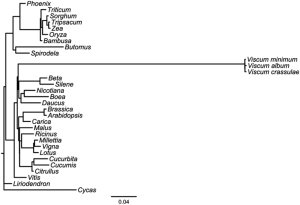
Mistletoe – great for making single people feel unloved at Christmas. Credit: Agnes Kantaruk/Shutterstock.
Mistletoe is held in high regard at this time of year. No Christmas decorations are complete without a garland of cheerful mistletoe hanging on the door, or suspended prettily from the rafters as an incentive for festive romance.
In nature, though, many species of mistletoe, such as Viscum album, are actually parasitic pests. They plug directly into the veins of other plants, and shamelessly siphon off water and nutrients. Viscum album is a hemiparasite, so it gets most of its nutrients from tapping host plants this way, but it still dabbles in photosynthesis, the process whereby light energy from the sun is converted into chemical energy.
Since parasites use their hosts to do most of their biological work for them, they typically trim down their DNA to remove the genetic instructions needed for now-redundant tasks. Plant cells – like animal cells – contain two separate sets of DNA: in the nucleus and in the mitochondria. Nuclear DNA orchestrates most of the functions of the cell, while mitochondrial DNA generates the power to fuel these cellular activities. Roughly half of the genes encoded by mitochondrial DNA are dedicated to producing energy in the respiratory chain and the TCA cycle.
Genetic Mammoth or Mouse?
Although mistletoe is a parasite, the DNA housed in the nucleus of its cells paradoxically encodes one of the largest genomes found in angiosperms (flowering plants). Yet scientists at the University of Copenhagen have now shown that the DNA in mistletoe’s mitochondria is astoundingly genetically lean. In fact, Viscum album‘s mitochondrial genome encodes just 12 proteins*. To put this in context, Cycas taitungensis, an evergreen tree, has a comparatively mammoth mitochondrial genome encoding 41 proteins.
So, where did mistletoe’s mitochondrial genes go? Were they simply genomic dead wood that got the chop? Or did mistletoe never have a bulky mitochondrial genome in the first place? Scientists aren’t sure. But it’s possible that mistletoe has copied the approach that legumes like soybean and cowpea have taken: to jettison genes from the mitochondria and embed them in the nucleus, where they continue to work from a satellite location.
Gene Puzzle
Not only is the Viscum album mitochondrial genome peculiar because it encodes such a small number of proteins, but its genetic code is also so scrambled that it’s difficult to see how it could work properly. In fact, when you line up the mitochondrial DNA sequences of different plants, mistletoe genes are tremendously divergent, sticking way out on their own branch, thumbing their prickly haustorium at other plants (below).

Comparing the genetic sequence of three parasitic Viscum mistletoe species alongside other plants. Credit: Petersen et al 2015/Scientific Reports.
Having said that, these jumbled genes probably do have roles to play: we just haven’t got to the point where we can understand their code or how they work. Otherwise, it would be difficult to explain how juvenile mistletoe survives before it latches on to its host plant, since mitochondrial genes are usually critical for sustaining life.
There’s certainly a lot more work to be done to understand the nature of mistletoe’s particular brand of parasitism and its seeming genetic mishmash. For now, though, it’s probably time to put the pipette down, sit by a crackling fire with a glass of eggnog in one hand and a mince pie in the other, and appreciate the simple festive cheer of this parasitic angiosperm.
* In the same study, two other parasitic mistletoe species, Viscum minimum and Viscum crassulae, were found to encode just 10 proteins; these represent the smallest number of proteins produced from a mitochondrial seed plant genome currently on record, beating the previous record holder, the white campion (Silene latifolia), at 25 proteins.
Petersen G, Cuenca A, Møller IM, & Seberg O (2015). Massive gene loss in mistletoe (Viscum, Viscaceae) mitochondria. Scientific Reports, 5 PMID: 26625950




